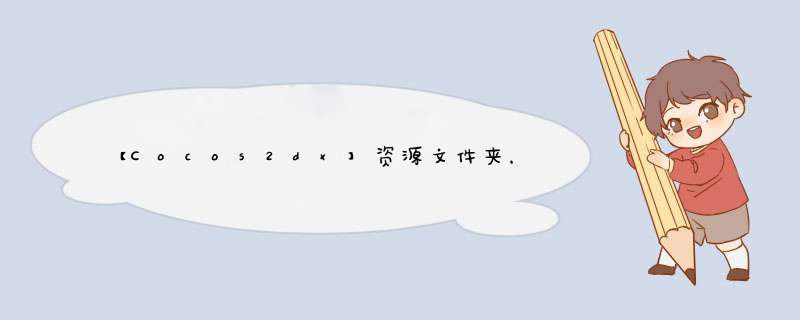
在Cocos2dx中播放背景音乐是一件很容易的事情,就一行代码,但是首先要导入Cocos2dx的音频引擎cocosDenshion。cocosDenshion对cocos2d工程提供了很方便的声音素材的调用和管理。同时要把要播放的音乐放到工程的资源文件夹才能正确播放
与《【Cocos2dx】windows平台下Cocos2dx 2.x的下载、安装、配置,打造自己的Helloworld》(点击打开链接)同样通过如下的Python命令,创建一个BGM工程之后:
python create_project.py -project BGM -package test.bgm -language cpp
你可以在此工程文件夹中找到Resources文件夹,你可以发现其中的内容就是早已被我们玩烂的HelloWorld.png与关闭按钮。
Cocos2dx用到所有图片、音乐资源都在必须在文件夹中才能够被调用。
我们再拷贝一个windows自带的实例音乐Kalimba.mp3进去,让我们的Cocos2dx程序在启动时,自动循环播放这个Kalimba.mp3音乐,也就是游戏的BGM。
直接打开proj.win32中的HelloCpp.sln。
对HelloCpp或只在HelloWorld这个场景播放BGM,则对其点击属性,如下图添加Cocos2dx的音频引擎cocosDenshion所需的包。就是把.(Cocos2dx)\CososDenshion\include这个文件夹全员引入到此工程或此cpp。
点击确定之后,我们只需要在HelloWorldScene.cpp中引入头文件#include "SimpleAudioEngine.h"同时在bool HelloWorld::init(){}中加入一行播放背景音乐的代码就可以了。最终HelloWorldScene.cpp的代码修改如下,其实没改什么。
#include "HelloWorldScene.h"#include "SimpleAudioEngine.h"//引入头文件USING_NS_CC;CCScene* HelloWorld::scene(){ // 'scene' is an autorelease object CCScene *scene = CCScene::create(); // 'layer' is an autorelease object HelloWorld *layer = HelloWorld::create(); // add layer as a child to scene scene->addChild(layer); // return the scene return scene;}// on "init" you need to initialize your instancebool HelloWorld::init(){ CocosDenshion::SimpleAudioEngine::sharedEngine()->playBackgroundMusic("Kalimba.mp3",true);//播放音乐 //区别于CocosDenshion::SimpleAudioEngine::sharedEngine()->playEffect("xx.wav");专门用来播放简短的音效 ////////////////////////////// // 1. super init first if ( !cclayer::init() ) { return false; } CCSize visibleSize = CCDirector::sharedDirector()->getVisibleSize(); CCPoint origin = CCDirector::sharedDirector()->getVisibleOrigin(); ///////////////////////////// // 2. add a menu item with "X" image,which is clicked to quit the program // you may modify it. // add a "close" icon to exit the progress. it's an autorelease object CcmenuItemImage *pCloseItem = CcmenuItemImage::create( "Closenormal.png","CloseSelected.png",this,menu_selector(HelloWorld::menuCloseCallback)); pCloseItem->setposition(ccp(origin.x + visibleSize.wIDth - pCloseItem->getContentSize().wIDth/2,origin.y + pCloseItem->getContentSize().height/2)); // create menu,it's an autorelease object Ccmenu* pMenu = Ccmenu::create(pCloseItem,NulL); pMenu->setposition(CCPointZero); this->addChild(pMenu,1); ///////////////////////////// // 3. add your codes below... // add a label shows "Hello World" // create and initialize a label cclabelTTF* pLabel = cclabelTTF::create("Hello World","Arial",24); // position the label on the center of the screen pLabel->setposition(ccp(origin.x + visibleSize.wIDth/2,origin.y + visibleSize.height - pLabel->getContentSize().height)); // add the label as a child to this layer this->addChild(pLabel,1); // add "HelloWorld" splash screen" CCSprite* pSprite = CCSprite::create("HelloWorld.png"); // position the sprite on the center of the screen pSprite->setposition(ccp(visibleSize.wIDth/2 + origin.x,visibleSize.height/2 + origin.y)); // add the sprite as a child to this layer this->addChild(pSprite,0); return true;}voID HelloWorld::menuCloseCallback(CCObject* pSender){#if (CC_TARGET_PLATFORM == CC_PLATFORM_WINRT) || (CC_TARGET_PLATFORM == CC_PLATFORM_WP8) CcmessageBox("You pressed the close button. windows Store Apps do not implement a close button.","Alert");#else CCDirector::sharedDirector()->end();#if (CC_TARGET_PLATFORM == CC_PLATFORM_IOS) exit(0);#endif#endif} 运行此程序,就可以听到Kalimba.mp3这个难听得要死的windows7示例音乐了。其中CocosDenshion::SimpleAudioEngine::sharedEngine()->playBackgroundMusic("Kalimba.mp3",true);中第一个参数就是此音乐在Resource文件夹的路径,true代表循环播放。 总结 以上是内存溢出为你收集整理的【Cocos2dx】资源文件夹,播放背景音乐,导入外部库全部内容,希望文章能够帮你解决【Cocos2dx】资源文件夹,播放背景音乐,导入外部库所遇到的程序开发问题。
如果觉得内存溢出网站内容还不错,欢迎将内存溢出网站推荐给程序员好友。
欢迎分享,转载请注明来源:内存溢出

 微信扫一扫
微信扫一扫
 支付宝扫一扫
支付宝扫一扫
评论列表(0条)